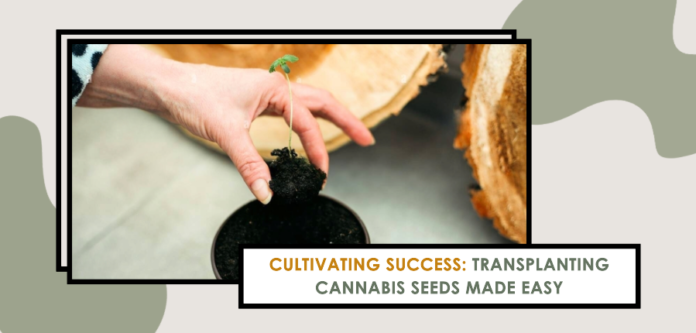Due to the increasing demand for recreational and medicinal use, the cultivation of cannabis has seen a remarkable expansion. A crucial aspect of this cultivation process involves the movement of plants and fresh soil between containers, which is the transfer of cannabis seeds. It is vital to understand the significance and advantages of transplanting cannabis seedlings as it plays a fundamental role in promoting robust and flourishing plant growth.
The transplantation of cannabis seedlings is crucial for their optimal growth and development. These young plants require specific environments that facilitate root growth, and timely transplantation ensures abundant space and nutrients for their thriving. By transplanting cannabis, the detrimental effects of overcrowding and resource competition on plant growth are significantly diminished. Additionally, relocating the seedlings to larger pots allows their roots to spread, facilitating improved water absorption and nutrient uptake from the soil. As a result, the overall health and vitality of the plants are elevated.
Know Before You Transplant Cannabis Seeds
To ensure a successful outcome, follow these step-by-step guidelines when transplanting cannabis seedlings:
1. Consider certain factors and assess the following steps before proceeding with transplantation.
2. Begin by selecting containers of suitable size and appropriate materials. The chosen containers should provide ample space for seedling growth and have proper drainage to prevent waterlogging. Containers that allow breathability and sufficient airflow to prevent root rot are ideal.
3. Prepare the soil or growing medium. Opt for nutrient-rich soil or medium with good drainage characteristics. Proper drainage is crucial to avoid waterlogging. Maintain the soil’s pH levels between 6.0 and 7.0 for optimal nutrient absorption. Enrich the soil’s nutrient content and improve drainage by incorporating compost, perlite, or vermiculite.
4. Timing is important when transplanting cannabis seedlings—transplant seedlings with strong roots and two to three sets of leaves. Careful timing is crucial to avoid stunted growth.
5. Before transplantation, provide pre-transplantation care. Ensure the seedlings are appropriately watered and fed. Maintain suitable moisture levels to establish robust roots. Avoid excessive watering to prevent waterlogging and root rot. Regulate watering practices to maintain optimal soil moisture. Additionally, use a balanced fertilizer to promote healthy growth and development of the seedlings.
By following these step-by-step guidelines, you can effectively carry out the transplanting of cannabis seedlings, ultimately enhancing their overall health and vitality.
The Only Way To Transplant Cannabis Seeds
To achieve a successful transplantation process, follow these step-by-step instructions:
Ensure the soil or growing medium is rich in nutrients and has good drainage.
1. Prepare the container with soil, leaving enough space to accommodate the seedling’s root ball.
2. Create a big hole in the center of the soil, ensuring it is large enough to hold the delicate root ball of the seedling.
3. Carefully remove the seedling from its previous container, keeping the roots intact and undamaged.
4. Place the seedling gently into the prepared hole, ensuring the surrounding soil adequately covers the root ball.
5. Use caution while watering the seedling, avoiding excessive saturation. The soil should be moist but not overly soaked.
6. Locate a suitable spot with abundant light and position the container accordingly. Provide the necessary nutrients as required to support vigorous growth.
7. During the initial days in its new environment, closely monitor the seedling for any signs of stress, such as wilting. Adjust watering or nutrient levels accordingly.
By following these step-by-step instructions, you can achieve a successful transplantation process for your cannabis seedlings.
How To Solve Transplant Issues
Strategies for Alleviating Transplant Shock involve creating a stable environment, temporarily reducing water and nutrient intake, minimizing physical disturbances, preventing waterlogging, addressing underwatering, dealing with nutrient deficiencies, and promptly resolving issues.
To establish a stable and stress-free environment, it is recommended to relocate the seedlings to a shaded area, reducing direct sunlight exposure. This helps minimize transplant shock by providing a more suitable environment for the plants to adapt.
To alleviate plant stress, reducing the amount of water and nutrients provided temporarily is advisable. This allows the seedlings to adjust to their new surroundings without being overwhelmed.
Avoid physically disturbing the seedlings during the critical transition period. Gentle handling and minimal movement help prevent additional stress on the plants.
To prevent waterlogging, refrain from overwatering the seedlings. Reduce the watering frequency and partially allow the soil to dry out between watering sessions. Proper drainage in the container is crucial, so ensure the soil is well-draining and that the container has drainage holes. Promoting good airflow around the seedlings also helps prevent excessive moisture buildup and reduces the risk of waterlogging.
Addressing underwatering involves increasing the watering frequency if signs of underwatering are observed. It is important to ensure the soil maintains adequate moisture levels to support healthy growth. Incorporating mulch or moisture-retaining substances into the soil can help maintain proper hydration and prevent rapid evaporation.
To deal with nutrient deficiencies, supplement the seedlings with necessary nutrients using fertilizers or organic amendments. It is also important to adjust the soil’s pH level to fall within the optimal range of 6.0-7.0, as this enhances nutrient uptake and addresses potential deficiencies.
Regularly monitor the growth of the seedlings to identify any potential issues. Observe the plants for signs of stress, nutrient deficiencies, or pest infestations. Be adaptable to environmental factors and make necessary adjustments to create an optimal growing environment, including adjusting lighting, temperature, and humidity levels. Address any problems or issues promptly to promote the healthy development of the seedlings after transplantation, taking appropriate measures to mitigate the identified issues and provide the necessary care.












